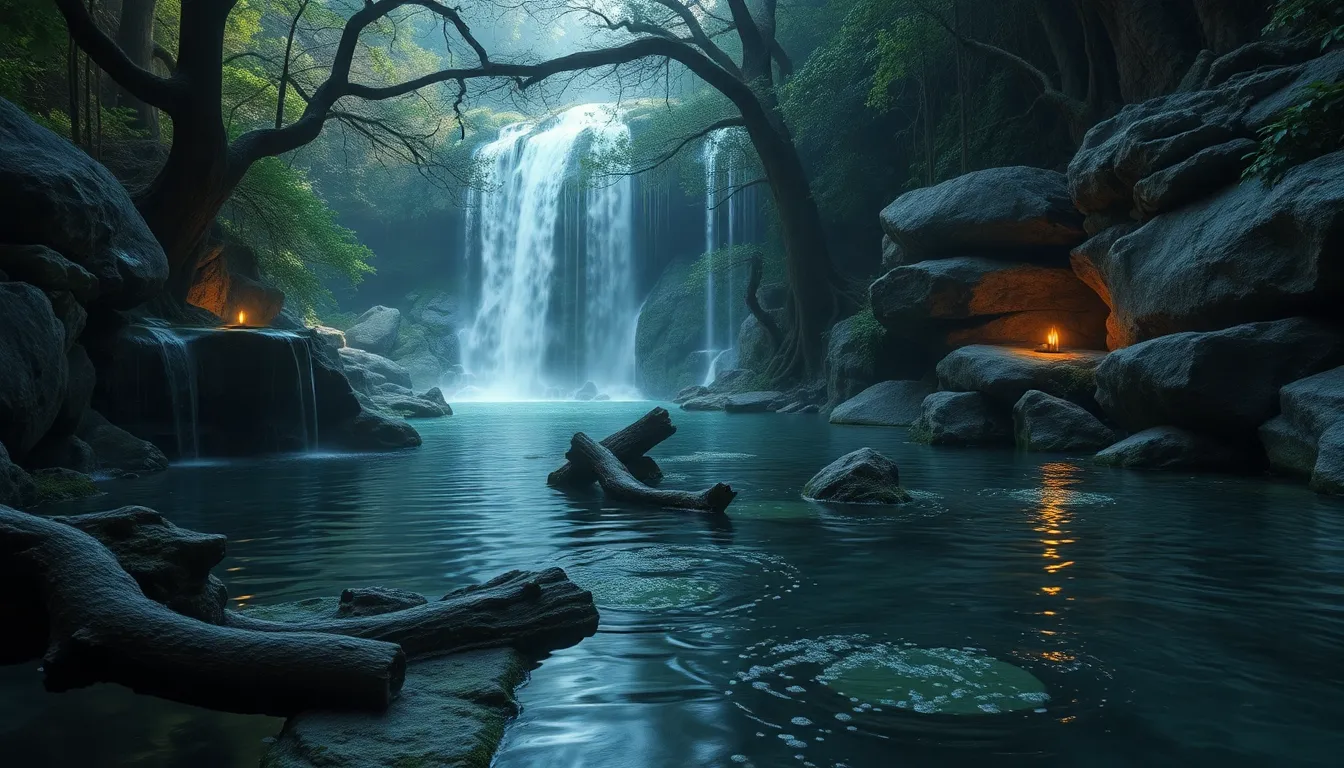The Allure of Sacred Springs: Water Sources in Mythology
I. Introduction
Sacred springs have long held a significant place in various cultures around the world. These natural water sources are often seen as holy, imbued with spiritual power and cultural importance. From ancient civilizations to modern spiritual practices, sacred springs symbolize a connection between the physical and the divine. Water, in mythology, serves as a vital element that resonates with humanity’s deepest existential questions.
This article aims to explore the allure of sacred springs in mythological narratives, examining their symbolism, cultural significance, and the lasting impact they have on communities and individuals alike.
II. The Symbolism of Water in Mythology
Water is a fundamental element in mythology, representing various aspects of life and existence. Its symbolism can be categorized into several key themes:
- Water as a life-giving force: In many cultures, water is viewed as essential for life. It nourishes plants, sustains animals, and provides for human needs.
- Duality of water: Water embodies both purification and destruction. While it can cleanse and heal, it can also flood and devastate, reflecting the dual nature of existence.
- Metaphor for transition and transformation: Water often symbolizes change, serving as a boundary between different states of being, such as life and death or innocence and experience.
III. Sacred Springs in Ancient Civilizations
Throughout history, sacred springs have played a pivotal role in the mythologies of ancient civilizations.
A. The role of sacred springs in Mesopotamian mythology
In Mesopotamian culture, water was viewed as a divine gift. The Tigris and Euphrates rivers were not only vital for agriculture but also considered sacred, where the gods were believed to reside. Springs were often associated with deities like Enki, the god of water and wisdom.
B. Greek mythology: the significance of springs like the Castalian Spring
In Greek mythology, springs held profound significance. The Castalian Spring, located at Delphi, was sacred to Apollo and was believed to provide prophetic powers. Pilgrims would visit the spring to purify themselves before consulting the oracle.
C. Roman water deities and their connection to sacred sources
The Romans revered several water deities, such as Neptune and his consort Salacia. Sacred springs were often dedicated to these gods, where rituals and offerings were made to ensure the flow and purity of the water, reflecting the deep connection between the divine and the natural world.
IV. Sacred Springs in Indigenous Mythologies
Indigenous cultures around the world have rich mythologies surrounding sacred springs, highlighting their importance in spiritual practices and community life.
A. The importance of springs in Native American myths
For many Native American tribes, springs are considered sacred places of healing and renewal. They are often seen as the dwelling places of spirits and are integral to creation stories and rituals.
B. Australian Aboriginal water sources and Dreamtime stories
In Aboriginal culture, water sources are deeply embedded in Dreamtime stories, which narrate the creation of the world and the ancestral beings that shaped it. Sacred springs are seen as life-giving sources that connect people to their ancestors.
C. African water spirits and their ties to sacred springs
African mythology features numerous water spirits associated with sacred springs. These spirits are often invoked for protection and fertility, with rituals performed to honor them and maintain harmony with nature.
V. Christian Perspectives on Sacred Springs
In Christianity, water is a powerful symbol of faith, purification, and rebirth.
A. The symbolism of baptismal waters
Baptismal waters represent the cleansing of sin and the initiation into the Christian faith. This act underscores the transformative power of water in spiritual contexts.
B. Historical significance of holy wells in Christian tradition
Holy wells are found throughout Europe, often believed to possess miraculous healing properties. These sites have become places of pilgrimage and devotion, where the faithful seek solace and healing.
C. Miraculous properties of sacred springs in saints’ legends
Many saints in Christian tradition are associated with springs that are believed to have miraculous properties. Stories abound of springs that cured illnesses or provided sustenance during times of need.
VI. Asian Mythologies and Sacred Waters
Asian cultures have various beliefs surrounding sacred waters that underscore their spiritual significance.
A. The Ganges River and its divine associations in Hinduism
The Ganges River is one of the holiest rivers in Hinduism, symbolizing purity and life. Pilgrims flock to its banks to wash away sins and seek spiritual enlightenment.
B. Japanese Shinto beliefs surrounding springs and waterfalls
In Shinto, natural water sources are considered sacred, embodying the kami (spirits). Ritual purification often involves water, and many shrines are situated near springs or waterfalls.
C. Chinese mythology: the healing properties of water in Taoism
In Taoism, water is revered as a source of life and healing. Springs are seen as places of balance and harmony, where individuals can reconnect with nature’s energy.
VII. The Cultural Impact of Sacred Springs in Folklore
Sacred springs have inspired a wealth of folklore and traditions that continue to shape cultural identities.
A. Legends and tales surrounding sacred springs across cultures
Folklore from around the world features numerous legends about sacred springs that grant wishes, bestow blessings, or serve as portals to the divine.
B. Festivals and rituals celebrating sacred water sources
Many cultures hold festivals dedicated to sacred springs, celebrating their importance through rituals, music, and dance. These events foster community spirit and cultural identity.
C. The role of sacred springs in promoting community and identity
Sacred springs often serve as gathering places for communities, promoting a sense of identity and shared history. They are crucial in cultural storytelling and the transmission of traditions.
VIII. Modern Interpretations and Revivals
In contemporary society, there is a renewed interest in sacred springs and their meanings.
A. Contemporary spiritual practices centered around sacred springs
Many people today engage in spiritual practices that honor sacred springs, seeking healing and connection with nature.
B. Environmental movements and the preservation of sacred waters
Environmental advocates emphasize the protection of sacred springs, recognizing their ecological importance and cultural significance. Efforts are underway to preserve these vital water sources for future generations.
C. The resurgence of interest in ancient myths and their relevance today
As society grapples with modern challenges, there is a growing interest in ancient myths and their teachings, particularly those related to nature and spirituality.
IX. The Allure and Mystique of Sacred Springs
The fascination with sacred springs extends beyond their physical presence; it encompasses psychological and emotional connections.
A. Psychological and emotional connections to water sources
Many individuals feel a deep emotional resonance with water, often finding solace and inspiration near sacred springs. These connections can evoke feelings of peace, rejuvenation, and introspection.
B. Artistic representations of sacred springs in literature and art
Sacred springs have inspired countless artistic works, from poetry to paintings, reflecting their beauty and spiritual significance. Artists often depict these sites as symbols of purity and transformation.
C. Personal narratives and experiences with sacred springs
Personal stories about encounters with sacred springs highlight their impact on individuals’ lives. Many recount transformative experiences tied to these water sources, emphasizing their power as places of healing and revelation.
X. Conclusion
In conclusion, sacred springs are more than just natural water sources; they are deeply woven into the fabric of mythology and culture across the globe. Their allure lies in their multifaceted symbolism and the myriad ways they connect humanity to the divine and to one another. From ancient civilizations to modern spiritual practices, sacred springs continue to inspire reverence, celebration, and community. As we navigate the complexities of contemporary life, the stories and significance of sacred springs remind us of our intrinsic connection to nature and the eternal quest for meaning.



